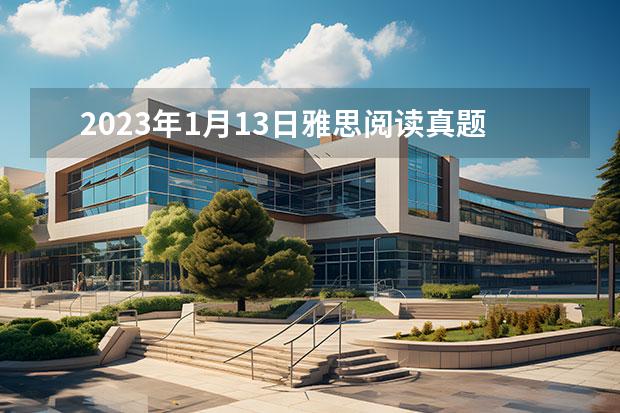小编今天整理了一些2023年1月13日雅思阅读真题回忆解析(雅思阅读的出题规律解析)相关内容,希望能够帮到大家。
本文目录一览:

2023年1月13日雅思阅读真题回忆解析
您好,我是专注留学考试规划和留学咨询的小钟老师。在追寻留学梦想的路上,选择合适的学校和专业,准备相关考试,都可能让人感到迷茫和困扰。作为一名有经验的留学顾问,我在此为您提供全方位的专业咨询和指导。欢迎随时提问!雅思考试是重要的考试之一,那么雅思真题是怎么样呢?不少人对此比较感兴趣,和小钟老师一起来看看2023年1月13日雅思阅读真题回忆解析!欢迎阅读。
2023年1月13日雅思阅读真题回忆解析
此次考试,第一篇和第三篇难度较小,第二篇难度较大,比较耗时。
Passage 1
题目
石油
话题分类
社会科学
题型及对应数量
T/F/NG(判断题)7
Short Answer Questions(填空题)6
内容回忆
文章大意:城市扩张能源紧缺,需要寻找新能源替代传统能源,有人对此进行了研究,并投资建立了公司。
答案:
1-7)判断
1.城市扩张需要这种石油去取代传统能源True
2.提取这种石油成分的科学家对于生产这种能源没有兴趣。False
3.很多人声称提取出来的成分是可以用来治疗疾病的。NG
4.研究人是相信这种成分是可以作为燃料来使用的。TRUE
5.In the 1985s,装这种石油的容器比这种石油本身要贵。TRUE
6.FALSE
7.第一条管道的建立收到了工人的抵制。TRUE
8-13)问答
8.创建的公司叫什么名字。standard oil
9.oil refiners
10.一个人从亚洲运回的除了油还有什么东西。sugar
11.运输用的红的桶使用什么材料制成的。Welsh tin
12.为什么做慈善,因为得了 关节炎
13.在什么领域进行了投资:Medical research
参考阅读
Passage 2
题目
Yawning打哈欠
话题分类
人文科学
题型及数量
段落信息匹配5
细节信息匹配 4
Summary(填空题)4
内容回忆
文章大意:对于打哈欠的研究
答案回忆:
14-18)Matching
14.C imagining leads to yawning
15.D occupation and inclination to yawning
16.A overview of research
17.B body temperature and yawning
18.B disapprove of a theory
19-22) Matching
有三个学校进行了研究,将三个学校跟四个研究成果进行配对
19.B not difference in gender
20.C mental disorder
21.A the way we breathe
22.B trained yawn more than the untrained
23-26)Summary
23.bond
24.danger
25.rest
26.acommunicationsystem
文章:
AWhen a scientist began to study yawning in the 1980s, it was difficult to convince some of his research students of the merits of“yawning science.”Although it may appear quirky (诡异) his decision to study yawning was a logical extension to human beings ofmy research in developmental neuroscience, reported in such papers as“Wing-flapping during Development and Evolution.” As a neurobehavioral problem, there is not much difference betweenthe wing-flapping of birds and the face- and body-flapping of human yawners.
BYawning is an ancient, primitive act. Humans do it even before they are born, opening wide in the womb (子宫) . Some snakes unhinge their jaws to do it. One species of penguins yawns as part of mating. Only now are researchers beginning to understand why weyawn, when we yawn and why we yawn back. A professor of cognitive neuroscience at Drexel University in Philadelphia, Steven Platek, studies the act of contagious yawning, something done only by people and other primates.
CIn his first experiment, he used a psychological test to rank people on their empathic (感情嵌入的) feelings. He found that participants who did not score high on compassion did not yawn back.“We literally had people saying,‘Why am I looking at people yawning?” Professor Platek said. “It just had no effect.”
DFor his second experiment, he put 10 students in an magnetic resonance imaging machine as they watched video tapes of people yawning. When the students watched the videos, the part of the brain which reacted was the part scientists believe controls empathy–the posterior cingulate (皮层的) , in the brain’s middle rear.”I don’t know if it’s necessarily that nice people yawn more, but 1 think it’s a good indicator of a state of mind,”said Professor Platek.“It’s also a good indicator if you’re empathizing with me and paying attention.”
EHis third experiment is studying yawning in those with brain disorders, such as autism and schizophrenia, in which victims have difficulty connecting emotionally with others. A psychology professor at the University of Maryland, Robert Provine, is one of the few other researchers into yawning. He found the basic yawn lasts about six seconds and they come in bouts with an interval of about 68 seconds. Men and women yawn or half-yawn equally often, but men are significantly less likely to cover their mouths which may indicate complex distinction in genders.”A watched yawner never yawns,,”Professor Provine said. However, the physical root of yawning remains a mystery. Some researchers say it’s coordinated within the hypothalamus (下丘脑) of the brain, the area that also controls breathing.
FYawning and stretching also share properties and may be performed together as parts of a global motor complex. But they do not always co-occur—people usually yawn when we stretch, but we don’t always stretch when we yawn, especially before bedtime. Studiesby J. I. P , G. H. A. Visser and H. F. Prechtl in the early 1980s, charting movement in the developing fetus using ultrasound, observed not just yawning but a link between yawning and stretching as early as the end of the first prenatal trimester (预产期).
GThe most extraordinary demonstration of the yawn-stretch linkage occurs in many people paralyzed on one side of their body because of brain damage caused by a stroke. The prominent British neurologist Sir Francis Walshe noted in 1923 that when these hemiplegics yawn, they are startled and mystified to observe that their otherwise paralyzed arm rises and flexes automatically in what neurologists term an“associated response.” Yawning apparently activates. undamaged, unconsciously controlled connections between the brain and the cord motor system innervating the paralyzed (瘫痪的) limb. It is not known whether the associated response is a positive prognosis for recovery, nor whether yawning is therapeutic for reinnervation(再生) or prevention of muscular atrophy.
HClinical neurology offers other surprises. Some patients with“locked-in” syndrome, who are almost totally deprived of the ability to move voluntarily, can yawn normally. The neural circuits for spontaneous yawning must exist in the brain stem near other respiratory and vasomotor centers, because yawning is performed by anencephalic(无脑畸形) who possess only the medulla oblongata (脊髓延髓). The multiplicity of stimuli of contagious yawning, by contrast, implicates many higher brain regions.
参考阅读
Passage 3
题目
Cinematographer新西兰电影
话题分类
人文科学
题型及数量
Y/N/NG(判断题)4
Multiple Choices(选择题)5
Summary(填空题)5
内容回忆
文章大意:介绍了新西兰的电影业,一开始文章提到了大家不了解电影摄影师的重要性也不了解摄影师和导演之间的关系。文章介绍了一名摄影师,这个摄影师在艺术和技术方面都很优秀,与优秀的女演员合作,两个人创造了很多经典的银幕形象。文章介绍了新西兰电影的发展以及对其的一些评价。
答案回忆:
27-30)判断题
27.cinematographer作用是帮助观众把关注点放在导演希望他们注意的点上。YES
28.cinematographer和director关系差NG
29.电影摄影师需要艺术和技术方面的能力。YES
30.两个人(一个摄影师一个女演员)工作时关系差。NG
31-36)选择题
31.文章讲新西兰电影是为想要说明什么:说明新西兰早期电影比较简单,跟其他国家比,较差。
32.讲的一部新西兰电影(两个单词开头都是B)这个电影跟新西兰其他电影相比取得了突破,比较成功。
33.还是说这部新西兰电影,说摄影师用了什么拍摄手法:用比较个人的风格展示了一个国家,城市和人民
34.讲问一个导演的第二部电影,(摄影师换了,换成了新人,手法比较写实,跟上一部不一样),选的是这部电影有unique version.
35.讲的还是这个导演第三部电影,问作者觉得他这部电影不好在哪里:故事线过于松散story line(loose).
36-40) Summary(选词填空)
36.文章讲了70年代电影关注countryside,选项rural areas
37.文章讲难度在environment, 选项:weather
38.讲解决问题的:rental company
39.还有一个问题是通过解决,文章说management,选项是:good leadership
40.最后一个是新西兰电影从业者与世界其他地方比的优势:文章说大家一起合作。选项是greater equality
以上是小编精心整理的2023年1月13日雅思真题回忆解析,谢谢浏览。
希望以上的答复能对您的留学申请有所帮助。如果您有任何更详细的问题或需要进一步的协助,我强烈推荐您访问我们的留学官方网站 ,在那里您可以找到更多专业的留学考试规划和留学资料以及一对一的咨询服务。祝您留学申请顺利!
雅思阅读的出题规律解析
分析雅思阅读真题的出题规律对于大家的雅思阅读备考有很大的好处,因为这样就可以节省很多的时间和精力。大家就可以把注意力集中放在最常出现的几个类别上面了。下面雅思就为大家整理了以雅思剑桥系列为准的对雅思阅读真题出题规律的分析。Test1的题型组合:5题段落归属配对题,7题段落小标题,8题归纳摘要题,12题是非无判断题,还有4题选择题,最后还有4题为完成句子填空题。从这个test我们可以看出它跟现行考试的'特点是完全符合的。
Test 2的题型组合:4题段落归属配对题,6题分类题,5题归纳摘要题,4题段落小标题,13题是非无判断题,4题完成句子ending题,还有4题选择题。Test2的题型比 Test1要更加丰富,不过总体而言,前三大题型的归属还是没有变化的。
Test3的题型组合:13题是非无判断题,6题信息配对题,6题分类题,6题段落小标题,7题归纳摘要题,还有4题选择题,6题填表题和2题选择题。Test 3 的题型设置跟前面两个test有些不同的地方。填表题和信息配对题在这个test中出现了。但是这类题目的难度并不高,因此整体难度并不大。
Test4的题型: 6题人名观点配对题,14题是非无判断题,11题归纳摘要题,6题完成句子题,3题选择题。在这篇试题中人名观点配对题的特殊之处在于:有一个选项是以上所有人名都不是,这在以前的雅思考试题型中都没有出现过。考生应对此类出题方式引起重视。
剑桥雅思阅读AUSTRALIA’SSPORTINGSUCCESS及答案解析
做好雅思的阅读题除了掌握对的 方法 ,也离不开我们日常的辛勤练习,下面我给大家带来剑桥雅思阅读AUSTRALIA’S SPORTING SUCCESS及答案解析,一起加油吧!
剑桥雅思阅读AUSTRALIA’S SPORTING SUCCESS
READING PASSAGE 1
You should spend about 20 minutes on Questions 1-13, which are based on Reading Passage 1 below.
AUSTRALIA’S SPORTING SUCCESS
A They play hard, they play often, and they play to win. Australian sports teams win more than their fair share of titles, demolishing rivals with seeming ease. How do they do it? A big part of the secret is an extensive and expensive network of sporting academies underpinned by science and medicine. At the Australian Institute of Sport (AIS), hundreds of youngsters and pros live and train under the eyes of coaches. Another body, the Australian Sports Commission (ASC), finances programmes of excellence in a total of 96 sports for thousands of sportsmen and women. Both provide intensive coaching, training facilities and nutritional advice.
B Inside the academies, science takes centre stage. The AIS employs more than 100 sports scientists and doctors, and collaborates with scores of others in universities and research centres. AIS scientists work across a number of sports, applying skills learned in one — such as building muscle strength in golfers — to others, such as swimming and squash. They are backed up by technicians who design instruments to collect data from athletes. They all focus on one aim: winning. ‘We can’t waste our time looking at ethereal scientific questions that don’t help the coach work with an athlete and improve performance,’ says Peter Fricker, chief of science at AIS.
C A lot of their work comes down to measurement — everything from the exact angle of a swimmer’s dive to the second-by-second power output of a cyclist. This data is used to wring improvements out of athletes. The focus is on individuals, tweaking performances to squeeze an extra hundredth of a second here, an extra millimetre there. No gain is too slight to bother with. It’s the tiny, gradual improvements that add up to world-beating results. To demonstrate how the system works, Bruce Mason at AIS shows off the prototype of a 3D analysis tool for studying swimmers. A wire-frame model of a champion swimmer slices through the water, her arms moving in slow motion. Looking side-on, Mason measures the distance between strokes. From above, he analyses how her spine swivels. When fully developed, this system will enable him to build a biomechanical profile for coaches to use to help budding swimmers. Mason’s contribution to sport also includes the development of the SWAN (Swimming Analysis) system now used in Australian national competitions. It collects images from digital cameras running at 50 frames a second and breaks down each part of a swimmer’s performance into factors that can be analysed individually — stroke length, stroke frequency, average duration of each stroke, velocity, start, lap and finish times, and so on. At the end of each race, SWAN spits out data on each swimmer.
D ‘Take a look,’ says Mason, pulling out a sheet of data. He points out the data on the swimmers in second and third place, which shows that the one who finished third actually swam faster. So why did he finish 35 hundredths of a second down? ‘His turn times were 44 hundredths of a second behind the other guy,’ says Mason. ‘If he can improve on his turns, he can do much better.’ This is the kind of accuracy that AIS scientists’ research is bringing to a range of sports. With the Cooperative Research Centre for Micro Technology in Melbourne, they are developing unobtrusive sensors that will be embedded in an athlete’s clothes or running shoes to monitor heart rate, sweating, heat production or any other factor that might have an impact on an athlete’s ability to run. There’s more to it than simply measuring performance. Fricker gives the example of athletes who may be down with coughs and colds 11 or 12 times a year. After years of experimentation, AIS and the University of Newcastle in New South Wales developed a test that measures how much of the immune-system protein immunoglobulin A is present in athletes’ saliva. If IgA levels suddenly fall below a certain level, training is eased or dropped altogether. Soon, IgA levels start rising again, and the danger passes. Since the tests were introduced, AIS athletes in all sports have been remarkably successful at staying healthy.
E Using data is a complex business. Well before a championship, sports scientists and coaches start to prepare the athlete by developing a ‘competition model’, based on what they expect will be the winning times.’ You design the model to make that time,’ says Mason.’ A start of this much, each free-swimming period has to be this fast, with a certain stroke frequency and stroke length, with turns done in these times.’ All the training is then geared towards making the athlete hit those targets, both overall and for each segment of the race. Techniques like these have transformed Australia into arguably the world’s most successful sporting nation.
F Of course, there’s nothing to stop other countries copying — and many have tried. Some years ago, the AIS unveiled coolant-lined jackets for endurance athletes. At the Atlanta Olympic Games in 1996, these sliced as much as two per cent off cyclists’ and rowers’ times. Now everyone uses them. The same has happened to the ‘altitude tent’, developed by AIS to replicate the effect of altitude training at sea level. But Australia’s success story is about more than easily copied technological fixes, and up to now no nation has replicated its all-encompassing system.
剑桥雅思阅读AUSTRALIA’S SPORTING SUCCESS题目
Questions 1-7
Reading Passage 1 has six paragraphs, A-F.
Which paragraph contains the following information?
Write the correct letter, A-F, in boxes 1-7 on your answer sheet.
NB You may use any letter more than once.
1 a reference to the exchange of expertise between different sports
2 an explanation of how visual imaging is employed in investigations
3 a reason for narrowing the scope of research activity
4 how some AIS ideas have been reproduced
5 how obstacles to optimum achievement can be investigated
6 an overview of the funded support of athletes
7 how performance requirements are calculated before an event
Questions 8-11
Classify the following techniques according to whether the writer states they
A are currently exclusively used by Australians
B will be used in the future by Australians
C are currently used by both Australians and their rivals
Write the correct letter, A, B or C, in boxes 8-11 on your answer sheet.
8 cameras
9 sensors
10 protein tests
11 altitude tents
Questions 12 and 13
Answer the questions below.
Choose NO MORE THAN THREE WORDS ANDIOR A NUMBER from the passage for each answer.
Write your answers in boxes 12 and 13 on your answer sheet.
12 What is produced to help an athlete plan their performance in an event?
13 By how much did some cyclists’ performance improve at the 1996 Olympic Games?
剑桥雅思阅读AUSTRALIA’S SPORTING SUCCESS答案
Question 1
答案:B
关键词:exchange of expertise, between different sports/collaborate, across a number of sports
定位原文:B段第2、3句“...and collaborates with… a number of sports …”
解题思路: 题干中讲到不同体育领域的专业知识交流正好跟原文中跨不同体育专家之间的合作相对应,理解意思即可容易找到正确答案。
Question 2
答案:C
关键词: visual imaging/3D, image
定位原文: C段第6句: “...shows off the prototype of a 3D analysis …”
解题思路: 通过题干中的视频成像可以很容易找到原文中对应的3D和成像。
Question 3
答案:B
关键词: a reason for narrowing/ can’t waste time
定位原文: B段最后1句: “We can’t waste our time looking…”
解题思路: 题目中的research activity和原文中的scientific questions 属于同义表达,定位答题区域,发现此句话所要表达的意思是不在一些飘渺的、不切实际的科学问题上浪费时间,也就是说要缩小研究的范围。
Question 4
答案:F
关键词:AIS ideas reproduce/ copying
定位原文: F段第1句话 “Of course, there’s nothing…”
解题思路: 题干中的reproduce是复制的意思,之后从 文章 中发现 句子 有复制copying,即可以直接定位。
Question 5
答案:D
关键词:Obstacle, investigated/ impact, monitor
定位原文: D段第6句“... to monitor heart rate…”
解题思路: 题干提到理想成绩的障碍是如何被调查研究的,而读到对应句子之后看到正好是sensors(传感器)对于运动员跑步的impact(影响)进行研究的仪器,而且obstacles和impact对应。
Question 6
答案:A
关键词:Overview, funded support finance
定位原文: A段倒数第2句 “...finances programmes of excellence…”
解题思路: finances是解题关键,意思为资助,正好跟题干中funded support表达了相同的义项,直接对应。而且之后一句话提及以上项目所提供的服务和建议,可以确信答案。
Question 7
答案:E
关键词:Calculated before an event/ using data, well before a championship
定位原文: E段第1句、第2句 “Using data is a complex business. Well before a championship, ...”
解题思路: 首先通过well before a championship和文章中before an event定位到E段, 之后发现后面提及的“竞争模型”作用就是计算时间和速率,因此内容对应上calculate,此时可断定答案的位置。
Question 8
答案:A
关键词: digital cameras
定位原文: C段倒数第3句: “..SWAN system now used in Australian national…”
解题思路: 前一句已经提到该系统已广泛应用于澳大利亚各项全国赛事之中,而没有提到其他国家,因此可以判断应该只有澳大利亚人在使用。
Question 9
答案:B
关键词:sensor
定位原文: D段第7句:“...With the Cooperative Research Centre for Micro…”
解题思路: 找到相同对应词sensor,读其前后的句子,发现有 Melbourne,断定是澳大利亚人的发明。之后要特别留心动词develop运用现在进行时,表示正在开发;而且注意之后的定语从句采用了将来时,所以可以断定此发明还没有完成,应该属于将来的成果。因此选择B。
Question 10
答案: A
关键词:protein
定位原文: D段倒数第4句: “… AIS and the University of Newcastle…”
解题思路: 非常容易在前面第一句话中找到跟题目protein tests所对应的词语a test ...protein。之后细读前后句,发现后面一句话对于此项科技成果的受益者文章中只提到AIS运动员,即澳大利亚体育学院的运动员,隶属于澳大利亚,所以应该选择A。
Question 11
答案:C
关键词: altitude tent
定位原文: F段倒数第2句: “The same has happened to the ‘altitude tent ’…”
解题思路: 文章中很容易找到用引号括起来的题目中的名词 短语 ,因此只要细心读原句,就会发现开头的‘The same has happened...’同样的事情也发生在……根据 经验 应该顺着文章向上追溯,发现跟‘altitude tent’相同情况的是1996年奥运会上澳大利亚人受益的流线型散热运动服现在全世界都在用。因此 ‘altitude tent’也被世界各国应用。所以答案应该选择C。且根据此段话大意可以了解文章只提到两种研究成果被别国运用,即髙原帐蓬和流线型散热服。所以可以间接判断前三项成果是由澳大利人独享的。
Question 12
答案: (a)competition model
关键词: help an athlete plan, produced / prepare the athlete by, developing
定位原文: E段第1句“Using data…”
解题思路: Help an athlete plan their performance 对应上prepare the athlete by之后,要认真研究题目所问的是what is produced,断定所作答案必定要填一个名词。因此要细读原文发现有单词developing恰与produced相对应,中文意思是“开发”,则答案必定是开发之后的名词。
Question 13
答案: (by)2 percent/%
关键词: 19% Olympic Games, cyclists, improve
定位原文: F段第3句“At the Atlanta…”
解题思路: 分析问句是 ‘By how much... improve’,意思为“提高了多少”,可以判断出答案需要写一个数字。因此仔细阅读相关语句找到 sliced as much as two per cent off cyclists ‘and rowers’ time。很快就可以找到数字百分之二
。
以上就是金博宝188官网小编为大家带来的内容了,想要了解更多相关信息,请关注金博宝188官网。









